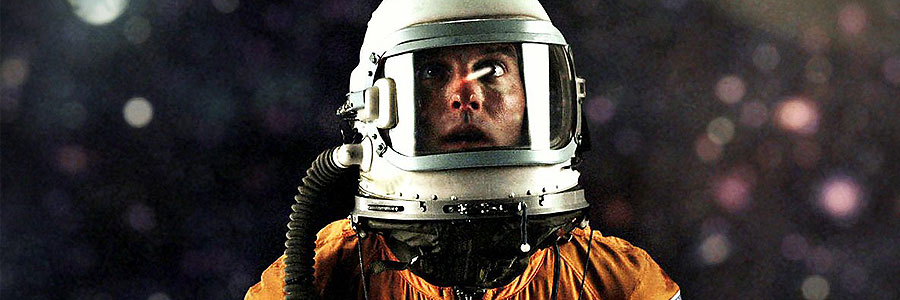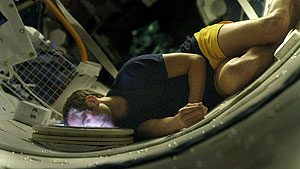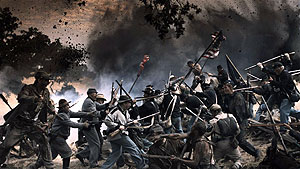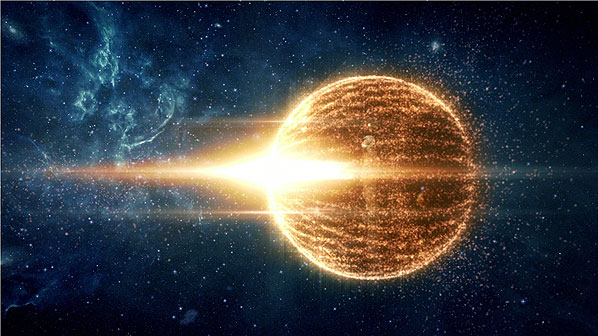
Love

LOVE (MOVIE)
New Dog Media
Original release: August 10th, 2011
Running time: 86 minutes
Director: William Eubank
Writer: William Eubank
Cast: Gunner Wright
Music: Angels & Airwaves

“Look again at that dot. That’s here. That’s home. That’s us. On it everyone you love, everyone you know, everyone you ever heard of, every human being who ever was, lived out their lives. The aggregate of our joy and suffering, thousands of confident religions, ideologies, and economic doctrines, every hunter and forager, every hero and coward, every creator and destroyer of civilization, every king and peasant, every young couple in love, every mother and father, hopeful child, inventor and explorer, every teacher of morals, every corrupt politician, every “superstar,” every “supreme leader,” every saint and sinner in the history of our species lived there-on a mote of dust suspended in a sunbeam.”
~ Carl Sagan, Pale Blue Dot (1994)
On February 14th, 1990, the Voyager 1 space probe photographed planet Earth from a distance of about 6 billion kilometres as part of the Family Portrait series of images of the Solar System. In this single photograph, Earth’s apparent size is less than a pixel; our planet appears as a tiny dot against the vastness of space, among bands of sunlight scattered by the camera’s optics. Voyager had already completed its mission and was leaving the Solar System, but was commanded by NASA to turn its camera around and take one last photograph of Earth across a great expanse of space, at the request of astronomer and author Carl Sagan. The above quote is from him and it really helps us put things into perspective as we look at this film.
Directed by William Eubank and produced and scored by the band Angels & Airwaves, Love is science fiction drama that, looking back on it now, shares something in common with films such as Kubrick’s 2001: A Space Odyssey, Duncan Jones’ Moon and Christopher Nolan’s Interstellar. Not because of their special effects, but more because of how they feel as films. Taken together, they’re more like tone poems; filmmakers’ musings on the human condition vs. the infinite outthereness of space, as well as what it would be like to be completely removed from this “mote of dust suspended in a sunbeam”, as Sagan puts it.
Its main character, United States Astronaut Lee Miller (Gunner Wright), is on the International Space Station (ISS) in the year 2039. His mission, as a one-man skeleton crew, is to examine if it’s still safe and operational after it was abandoned two decades earlier for reasons unknown. However, soon after arriving, an unknown event back on Earth causes Miller to lose contact with mission control at CAPCOM and he finds himself stranded in orbit alone, forced to helplessly watch life on his home planet grind to halt from portholes 200 miles above.

As the film goes on to explore the psychological effects of isolation and loneliness, we see Miller struggling to maintain his sanity while in isolation by interacting with Polaroid pictures of former ISS crew members left aboard the ship. At first he thinks it’s some kind of practical joke they’re playing on him at CAPCOM, but as time passes he becomes increasingly frustrated by their lack of communication. This frustration then erupts into anger, then panic, and gradually despair as he’s left to ponder what’s happened back on Earth. There’s nothing he can do but watch as life on this pale blue dot fades away. For all its imperfections, all its horrors, all the pain, life on Earth is the only thing we know and now it’s slipping from his grasp.
Intertwined with this narrative are two other elements. Love also offers us documentary-style interviews with characters that aren’t really part of the story, but we’re able to deduce they’re somehow connected to Miller. They tell us their own stories about things that have happened to them, they share personal insights about what human relationships mean to them and they give us a glimpse of what Eubank wants to let us in on. The other thread the film tries to unwind is set in 1864 during the American Civil War. It’s the story of lone Union soldier Captain Lee Briggs (also played by Horne) who’s sent on a mission to investigate a mysterious object reported to Union forces. 175 years later Miller will also come into contact with the mysterious object Briggs was looking for.
Scenes of the Civil War are cut together with those of Miller on the ISS and the juxtaposition of Earth and space do not go unnoticed, especially against a musical score that so easily holds them both together. However, the film isn’t without its flaws. The interviews don’t really add much to the overall story; they don’t have the same emotional impact as when Nolan did it a few years later with Interstellar.  Emotional impact is by and large what’s lacking with Love. Given such a title I would have expected much more feeling from the story, but I never truly got that with Miller. His fantasies seem superficial, his frustrations are only that and his actual connections to people back on Earth are never explored in any meaningful way that would make us feel emotionally invested in even the slightest chance of him returning home. As a result, the drawn out scenes of him attempting suicide 200 miles above the Earth kind of fall flat, in an ironic sort of way.
Emotional impact is by and large what’s lacking with Love. Given such a title I would have expected much more feeling from the story, but I never truly got that with Miller. His fantasies seem superficial, his frustrations are only that and his actual connections to people back on Earth are never explored in any meaningful way that would make us feel emotionally invested in even the slightest chance of him returning home. As a result, the drawn out scenes of him attempting suicide 200 miles above the Earth kind of fall flat, in an ironic sort of way.
There’s also the problem of gravity on board the ISS. On the real ISS astronauts experience what’s known as microgravity. The Hitchhiker’s Guide to the Galaxy states: “There is an art to flying, or rather a knack. Its knack lies in learning to throw yourself at the ground and miss.” The ISS and its occupants are falling because of the Earth’s gravitational field, but their tangential momentum means that they keep missing and therefore orbit the Earth. Since they are falling at the same rate, the occupants appear to float inside. This is microgravity, in a nutshell.
While Love may not be as memorable or match the grandeur of Kubrick’s and Nolan’s efforts, or the intellect of Jones, it is a visually appealing piece of cinema. In comparison to those aforementioned films though, and many other movies it shares its genre with, it is like a dot in the vastness of cinema that most viewers are likely to overlook.


Patrick Samuel
The founder of Static Mass Emporium and one of its Editors in Chief is an emerging artist with a philosophy degree, working primarily with pastels and graphite pencils, but he also enjoys experimenting with water colours, acrylics, glass and oil paints.
Being on the autistic spectrum with Asperger’s Syndrome, he is stimulated by bold, contrasting colours, intricate details, multiple textures, and varying shades of light and dark. Patrick's work extends to sound and video, and when not drawing or painting, he can be found working on projects he shares online with his followers.
Patrick returned to drawing and painting after a prolonged break in December 2016 as part of his daily art therapy, and is now making the transition to being a full-time artist. As a spokesperson for autism awareness, he also gives talks and presentations on the benefits of creative therapy.
Static Mass is where he lives his passion for film and writing about it. A fan of film classics, documentaries and science fiction, Patrick prefers films with an impeccable way of storytelling that reflect on the human condition.
© 2022 STATIC MASS EMPORIUM . All Rights Reserved. Powered by METATEMPUS | creative.timeless.personal. | DISCLAIMER, TERMS & CONDITIONS
HOME | ABOUT | CONTACT | TWITTER | GOOGLE+ | FACEBOOK | TUMBLR | YOUTUBE | RSS FEED
CINEMA REVIEWS | BLU-RAY & DVD | THE EMPORIUM | DOCUMENTARIES | WORLD CINEMA | CULT MOVIES | INDIAN CINEMA | EARLY CINEMA
MOVIE CLASSICS | DECONSTRUCTING CINEMA | SOUNDTRACKS | INTERVIEWS | THE DIRECTOR’S CHAIR | JAPANESE CINEMA





